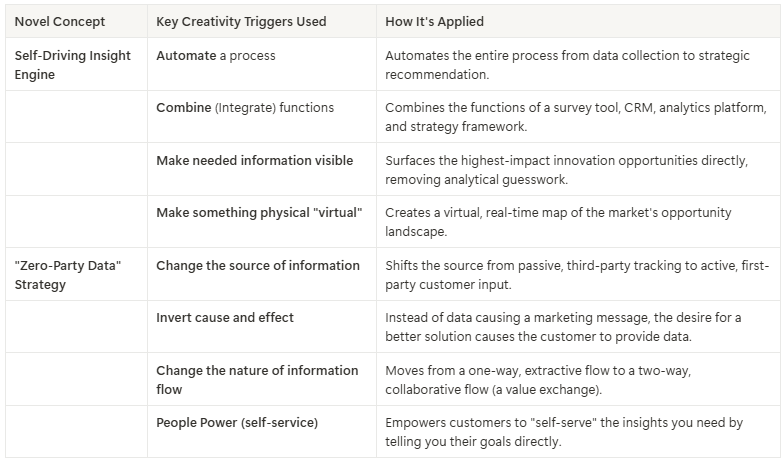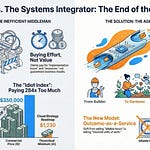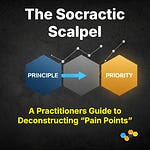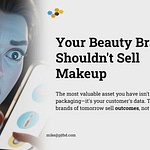🚨🚨🚨🚨🚨🚨
Before I dive in, I just dramatically reduced the price of my original JTBD Masterclass on using AI to reduce most of the consulting work needed for qualitative JTBD innovation research. It started at nearly $1000 almost two years ago. I’ve just dropped it from $197 to $67 (65%). So, if budget was an issue, it shouldn’t be any more. It’ll be gone soon…I do mean the product. So, hurry if you have any interest!
Now back to your regularly schedule Blogcast.
You’re sitting on a goldmine of data. Your CRM is bursting with profiles, your analytics platform tracks every click, and your spreadsheets can scroll for miles. You have data on what your customers look like, where they live, and what they do.
So why does shipping a winning product still feel like a coin flip?
This is the great paradox of the Big Data era. We have more information than ever, but we’re starving for real insight. The hard truth is that most of the data you’re so carefully collecting is noise. It’s a distraction that leads to flawed strategies, wasted resources, and products that miss the mark.
The solution isn't a more powerful algorithm or a bigger data lake. It’s a fundamental shift in perspective. It’s about moving away from collecting more data and starting to collect the right data. This post will give you a complete, first-principles framework to find that 1% signal in the 99% noise—the signal that unlocks predictable innovation.
The Great Data Deception: Why We're Drowning in Noise
For the last decade, we’ve been sold a simple promise: more data equals better decisions. We built massive infrastructures to capture everything, believing that somewhere in that digital haystack, we’d find the needle of truth. But it hasn’t worked out that way, and here’s why.
The Correlation vs. Causation Trap
The vast majority of your data is correlational. It tells you what happened, but it can never tell you why.
Think about it. Your analytics can tell you that users who click feature A are 20% more likely to retain. That's a correlation. But does that mean you should force everyone to use feature A? Of course not. You’re missing the underlying cause. What goal were those users trying to accomplish? What was their motivation?
Behavioral data shows you the shadow, but it can’t show you the object casting it. Demographic data is even worse. Knowing your customer is a 35-year-old urban professional is a bundle of correlations, not a reason for purchase. People don’t buy things because of who they are; they buy things to help them make progress in their lives. Innovation based on correlation is just sophisticated guesswork.
The CRM Graveyard
Most Customer Relationship Management (CRM) platforms are not living sources of insight; they are digital graveyards. They are meticulously organized archives of context-free facts.
Your CRM knows a customer's company size, their job title, and that they’ve opened 10 of your marketing emails. What it doesn’t know is the most important thing: what they’re struggling with. It has no record of the progress they are trying to make. Without that context, your data is lifeless. It can’t inform your product roadmap or your marketing messages in a meaningful way.
Case Studies in Data-Rich, Insight-Poor Failure
Consider a hypothetical company, let’s call them “Clickalytics.” They sold a powerful website analytics tool. They had terabytes of data on their own users: what reports they ran, which dashboards they customized, how long they hovered over certain buttons.
Using this data, they saw that “power users” frequently used their complex "Funnel Builder" feature. So, they spent a year and millions of dollars making the Funnel Builder even more powerful, adding dozens of new options. They launched it, and... nothing. Engagement barely moved, and churn remained high.
Why? They mistook correlation for cause. They saw what their best users were doing, but never asked why. The real "job" their customers were hiring the tool for wasn't "to build funnels"; it was "to persuade my boss to approve my marketing budget." The existing Funnel Builder was just the clunky tool they used for that job. A better solution might not have been a more complex funnel builder at all, but a simple, one-click report generator that was easy to share with executives.
Clickalytics had all the data in the world, but they were blind to the actual customer need.
A First-Principles Approach to Customer Data
To fix this, we have to go back to the beginning. We need to stop making assumptions and break down the concept of "customer data" to its fundamental truths.
First Principle #1: People 'hire' products to get Jobs done.
This is the core of the Jobs-to-be-Done (JTBD) theory. Your customers have goals. They have things they are trying to accomplish. When they buy your product, they are "hiring" it to help them get that job done. When it no longer does the job well, or a better alternative comes along, they "fire" it. This simple metaphor changes everything. It reframes the goal from "selling a product" to "helping a customer make progress."
First Principle #2: The Job is the unit of analysis.
If the goal is to help customers make progress, then the unit of analysis for your data strategy shouldn't be the customer persona or the product—it should be the "job." Personas are misleading bundles of correlation. Products are temporary solutions. The customer's job—what they are fundamentally trying to accomplish—is a much more stable and powerful focal point for understanding value.
First Principle #3: The Job is stable; solutions change.
This is the most powerful principle for building a long-term, strategic data asset. People have been trying to "share information with others" for millennia. The solutions have changed—from town criers to the printing press to email to Slack—but the core job remains the same.
Data about your product's UI is fleeting. Data about your customer's underlying job is timeless. By collecting data about the job, you are building an asset that will guide your innovation strategy for years, regardless of how technology evolves.
The "Right Data" Framework: A Practical Guide to Capturing Signal
When you adopt these first principles, a new picture of the "right data" emerges. It's not about demographics or clicks. It's about deconstructing the customer's job.
The Anatomy of a Job: Functional, Emotional, and Social
Every job has three dimensions, and you need to capture data on all of them:
Functional: The practical, task-oriented goal. (e.g., cut the grass)
Emotional: How the customer wants to feel. (e.g., feel a sense of peace in a well-ordered environment)
Social: How the customer wants to be perceived by others. (e.g., be seen as a responsible homeowner by my neighbors)
Ignoring the emotional and social components is a critical error. They are often the most powerful drivers of purchase decisions.
Desired Outcomes: The DNA of Customer Value
This is it. This is the 1% signal. The most valuable, actionable, and predictive data points you can possibly collect are the customer's Desired Outcomes.
A desired outcome is a metric the customer uses to judge how well the job is getting done. It's their definition of success. These statements have a specific, rigorous format that makes them incredibly powerful:
Direction of Improvement + Metric + Object of Control + Contextual Clarifier
Here are some examples:
Minimize + the time it takes + to prepare the documents + before a client meeting.
Increase + the likelihood + of identifying a critical error + when reviewing a spreadsheet.
Reduce + the chance + of feeling anxious + while waiting for test results.
This is the "Right Data." It's solution-agnostic, unambiguous, measurable, and directly tied to the customer's goal. A list of 100-150 desired outcomes for a given job is your blueprint for innovation.
The Universal Job Map
So, where do you find these outcomes? You find them by mapping the customer's process. The Universal Job Map breaks any functional job down into eight fundamental steps.
Define: Determine goals and plan resources.
Locate: Gather the necessary inputs and information.
Prepare: Set up the environment and the inputs.
Confirm: Verify readiness to execute the job.
Execute: Perform the core of the job.
Monitor: Check if the job is being executed successfully.
Modify: Make alterations to improve execution.
Conclude: Finish the job, including any necessary cleanup or reporting.
By interviewing customers about their process through these eight steps, you can systematically uncover their desired outcomes.
Prioritizing What Matters (Without Flawed Metrics)
Once you have a list of outcomes, you need to know which ones to focus on. For years, the standard approach in Outcome-Driven Innovation used a formula called the "Opportunity Score." However, extensive analysis has shown this formula can be misleading. It has a built-in bias, it amplifies statistical error, and it can incorrectly prioritize needs, leading you down the wrong path.
A more modern, transparent, and statistically sound approach is what's called the Percentages and Ranks method.
Instead of a complex, opaque formula, this method is based on straightforward questions you ask a representative sample of your market. The first question always focuses on importance:
On a scale of 1-5, how important is this outcome to you?
For the second question, you have a few powerful options depending on the job you're studying:
Satisfaction: On a scale of 1-5, how satisfied are you with your ability to achieve this today? (Good for understanding general sentiment).
Effort: On a scale of 1-5, how much effort does it take to achieve this today? (Excellent for identifying friction and complexity).
Both: In some cases, you might ask about both to get a complete picture of the customer's struggle.
From this simple data, you calculate clear, intuitive metrics:
The percentage of people for whom the outcome is highly important but they are not satisfied (or find it requires high effort).
The percentage of people who rank this outcome as a top priority struggle.
This approach gives you a direct, easy-to-understand view of the market's biggest pain points. It replaces a black box formula with transparent, actionable insight. It tells you exactly where customers are struggling the most, giving you a clear, data-driven focus for innovation.
The Future of Data Strategy: From Collection to Competitive Moat
Adopting this framework doesn't just give you better data; it transforms your entire approach to growth.
Working Today (That Few Are Doing): The Jobs-Based First-Party Data Strategy
You can start this shift right now, with the tools you already have.
Transform your surveys: Stop asking "How would you rate feature X?" and start asking, "When you are trying to [get job done], how important is it to [achieve desired outcome]?"
Enrich your CRM: Start tagging support tickets and sales call notes with keywords related to customer jobs and desired outcomes. You'll build a qualitative database of real struggles that is far more valuable than any demographic field. This gives your sales and marketing teams superpowers. They can now engage with customers on the basis of the problems they're trying to solve, not the product they're trying to sell.
Novel Concepts (That Redefine the Game)
Looking ahead, this "Right Data" approach unlocks entirely new, disruptive possibilities.
The Self-Driving Insight Engine: Imagine a single platform that gets the higher-level job of "making a data-driven growth decision" done. It would use AI to listen to sales calls, read support tickets, and analyze reviews to automatically extract and quantify desired outcomes. It would then map the top opportunities directly to Doblin's 10 Types of Innovation, suggesting not just product features, but process improvements, new service offerings, or channel partnerships. This system replaces a dozen disconnected tools with one integrated engine that goes from raw customer conversation to a complete innovation strategy. It uses less data to deliver more wisdom.
The Shift to "Zero-Party Data": In a world growing tired of surveillance, the "Right Data" is your key to building trust. Zero-party data is data that customers intentionally and proactively share with you. Why would they do that? Because you create a value exchange. Instead of tracking their clicks, you ask them directly: "Help us understand your struggles with [the job], and we will build solutions that solve them." JTBD gives you the precise language to have this conversation. It's a more ethical, more transparent, and infinitely more powerful way to understand your customers.
Building a Moat with Doblin’s 10 Types of Innovation
This is the ultimate strategic payoff. The "Right Data" isn't just about building a better product (Product Performance). It’s a springboard for innovating across your entire business, creating a deep, sustainable competitive advantage. Innovating across multiple types at once creates a combination that is incredibly difficult for competitors to copy.
Does your "Right Data" show customers struggle with the Prepare step of their job? Don't just add a feature. You could create a new onboarding Service (Type 7), fundamentally change your internal fulfillment Process (Type 4), or partner with another company via your Network (Type 2) to handle preparation for them.
One piece of causal "Right Data" can inspire innovations across three or four different types, building a complex moat around your business that a competitor focused only on features can never cross.
Novel Concepts & Creativity Triggers
To illustrate how these future concepts can be sparked, here's how they relate to systematic creativity triggers.
The era of "Big Data" is over. It was a paradigm built on a flawed premise—that quantity could make up for quality. It led us to become digital hoarders, collecting mountains of correlational noise while missing the simple, causal signals that actually matter.
The future belongs to those who embrace the "Right Data." It’s a future built on a first-principles understanding of customer motivation. It requires discipline, empathy, and a relentless focus on the customer's Job-to-be-Done. By capturing and acting on their desired outcomes, you can move from guesswork to a predictable science of innovation. You can stop chasing noise and start building what you know your customers will value.
What is the most useless metric your company religiously tracks? What Job-to-be-Done could you be focusing on instead? Why don’t you think these concepts could be implemented? Share your story in the comments.
Follow me on 𝕏: https://x.com/mikeboysen
If you'd like to see how I apply a higher level of abstraction to the front-end of innovation, please reach out. My availability is limited.
Mike Boysen - www.pjtbd.com
Why fail fast when you can succeed the first time?
Masterclass: https://pjtbd.com/mc
My Blog: https://jtbd.one
📆 Book an appointment: https://pjtbd.com/book-mike
Join our community: https://pjtbd.com/join












